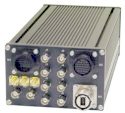Great Gadget Smack-Down Round 4 — Backgrounder
December 20, 2005 It's the beginning of Round Four in this knock-down, drag-out battle between Windows and Linux for the hearts and minds of developers building gadgets like smartphones, PDAs, firewalls, and consumer entertainment equipment. (more…)
It's the beginning of Round Four in this knock-down, drag-out battle between Windows and Linux for the hearts and minds of developers building gadgets like smartphones, PDAs, firewalls, and consumer entertainment equipment. (more…)
 Foreword — LinuxDevices founder Rick Lehrbaum recently discussed the new 770 Internet tablet with Ari Jaaksi, Nokia's director of open source software operations.
Foreword — LinuxDevices founder Rick Lehrbaum recently discussed the new 770 Internet tablet with Ari Jaaksi, Nokia's director of open source software operations.  Foreword — LinuxDevices recently caught up with OSDL spokesperson Bill Weinberg, to discuss the organization's new Mobile Linux Initiative (MLI). Weinberg, who serves as the OSDL's representative to the MLI, filled us in on the initiative's early progress, strategy, and…
Foreword — LinuxDevices recently caught up with OSDL spokesperson Bill Weinberg, to discuss the organization's new Mobile Linux Initiative (MLI). Weinberg, who serves as the OSDL's representative to the MLI, filled us in on the initiative's early progress, strategy, and…  Japanese storage device vendor Buffalo has brought out a “Home Server” version of its NAS server aimed at home users. The “HS” models of its Linux-based TeraServers now include multimedia file management and serving software developed using a Linux SDK from tools and middleware vendor Mediabolic.
Japanese storage device vendor Buffalo has brought out a “Home Server” version of its NAS server aimed at home users. The “HS” models of its Linux-based TeraServers now include multimedia file management and serving software developed using a Linux SDK from tools and middleware vendor Mediabolic.  Belgian electronic payments specialist Banksys is shipping a Linux-powered secure payment terminal with cellular networking capabilities. The Xentissimo is a portable, battery-powered device based on an SoC (system-on-chip) with dual ARM cores, the company says.
Belgian electronic payments specialist Banksys is shipping a Linux-powered secure payment terminal with cellular networking capabilities. The Xentissimo is a portable, battery-powered device based on an SoC (system-on-chip) with dual ARM cores, the company says.  Bivio used embedded Linux to build an 8-port programmable network appliance platform targeting emerging and complex network applications requiring Layer 4-7 packet processing at wire speeds. The Bivio 500 features a PowerPC control processor, along with an undisclosed data plane processor.
Bivio used embedded Linux to build an 8-port programmable network appliance platform targeting emerging and complex network applications requiring Layer 4-7 packet processing at wire speeds. The Bivio 500 features a PowerPC control processor, along with an undisclosed data plane processor.  [Updated Nov. 21] — Eurotech is readying a DVR (digital video recorder) platform for trains and other harsh environments. The “Rugged DVR” is based on a passively cooled P133 or Celeron processor, with optional JPEG2000 or MPEG-4 capture/compression, GSM/GPRS (UMTS) radio, gigabit Ethernet, and USB 2.0 ports.
[Updated Nov. 21] — Eurotech is readying a DVR (digital video recorder) platform for trains and other harsh environments. The “Rugged DVR” is based on a passively cooled P133 or Celeron processor, with optional JPEG2000 or MPEG-4 capture/compression, GSM/GPRS (UMTS) radio, gigabit Ethernet, and USB 2.0 ports.  Arxceo used embedded Linux to build a small anti-reconnaissance, anti-intrusion device the size of an eyeglasses case. The Ally ip100 can be installed in front of wireless access points or at the edge of 100Mbps networks, where it provides behavior-based intrusion detection and prevention, the company says.
Arxceo used embedded Linux to build a small anti-reconnaissance, anti-intrusion device the size of an eyeglasses case. The Ally ip100 can be installed in front of wireless access points or at the edge of 100Mbps networks, where it provides behavior-based intrusion detection and prevention, the company says.  Sharp used embedded Linux to build a wireless network multimedia adapter that works with Windows XP PCs, and is available in Japan, only. The CE-MR01 supports wired and 802.11a/b/g wireless networks, comes with a remote, and includes an on-screen library and player interface.
Sharp used embedded Linux to build a wireless network multimedia adapter that works with Windows XP PCs, and is available in Japan, only. The CE-MR01 supports wired and 802.11a/b/g wireless networks, comes with a remote, and includes an on-screen library and player interface.  D-Link India used Linux to build a multi-service access router aimed at providing remote offices with network fault-tolerant access to corporate headquarters. The DRO-200i is based on an Intel XScale network processor, and uses V.35 as its primary WAN interface, with ISDN and dial-up backup.
D-Link India used Linux to build a multi-service access router aimed at providing remote offices with network fault-tolerant access to corporate headquarters. The DRO-200i is based on an Intel XScale network processor, and uses V.35 as its primary WAN interface, with ISDN and dial-up backup.